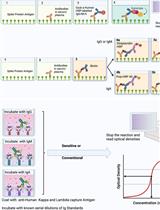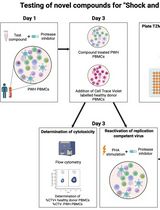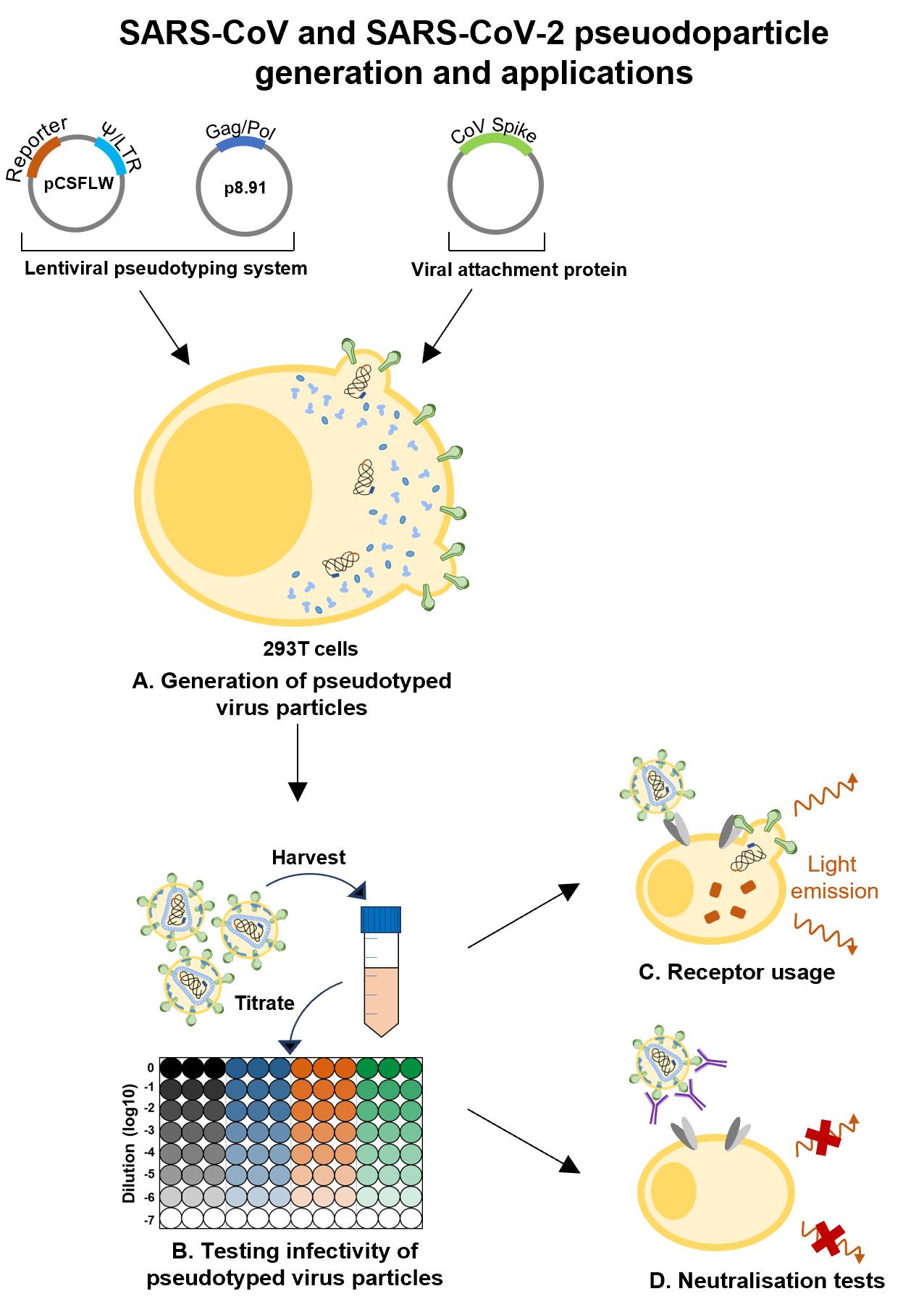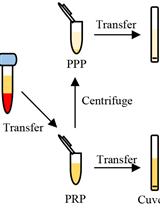- EN - English
- CN - 中文
Production of Recombinant Replication-defective Lentiviruses Bearing the SARS-CoV or SARS-CoV-2 Attachment Spike Glycoprotein and Their Application in Receptor Tropism and Neutralisation Assays
携带 SARS-CoV 或 SARS-CoV-2 附着尖峰糖蛋白的重组复制缺陷慢病毒的生产及其在受体向性和中和试验中的应用
发布: 2021年11月05日第11卷第21期 DOI: 10.21769/BioProtoc.4249 浏览次数: 4768
评审: Alexandros AlexandratosVasudevan AchuthanAnonymous reviewer(s)

相关实验方案

用于检测和定量人血浆或血清中抗病毒抗体的优化间接 ELISA 方案:以 SARS-CoV-2 为例的案例研究
Claire Baine [...] Jennifer Serwanga
2023年12月20日 3554 阅读

诱导型HIV-1库削减检测(HIVRRA):用于评估外周血单个核细胞中HIV-1潜伏库清除策略毒性与效力的快速敏感方法
Jade Jansen [...] Neeltje A. Kootstra
2025年07月20日 2393 阅读
Abstract
For enveloped viruses, such as SARS-CoV-2, transmission relies on the binding of viral glycoproteins to cellular receptors. Conventionally, this process is recapitulated in the lab by infection of cells with isolated live virus. However, such studies can be restricted due to the availability of high quantities of replication-competent virus, biosafety precautions and associated trained staff. Here, we present a protocol based on pseudotyping to produce recombinant replication-defective lentiviruses bearing the SARS-CoV or SARS-CoV-2 attachment Spike glycoprotein, allowing the investigation of viral entry in a lower-containment facility. Pseudoparticles are produced by cells transiently transfected with plasmids encoding retroviral RNA packaging signals and Gag-Pol proteins, for the reconstitution of lentiviral particles, and a plasmid coding for the viral attachment protein of interest. This approach allows the investigation of different aspects of viral entry, such as the identification of receptor tropism, the prediction of virus host range, and zoonotic transmission potential, as well as the characterisation of antibodies (sera or monoclonal antibodies) and pharmacological inhibitors that can block entry.
Graphic abstract:

SARS-CoV and SARS-CoV-2 pseudoparticle generation and applications.
Background
Pseudoparticles are replication-defective viral particles obtained through expression of viral envelope glycoproteins on the surface of a recombinant virus, which provides the core components of the particle. Vesicular stomatitis virus (VSV), a rhabdovirus, and two lentiviruses – human immunodeficiency virus-1 (HIV-1) and murine leukaemia virus (MuLV) – are commonly used as viral vectors for pseudotyping (Takada et al., 1997; Wool-Lewis and Bates, 1998; Sharkey et al., 2001; Negrete et al., 2005; Grehan et al., 2015; Thakur et al., 2021). In our recent study, we successfully used a lentiviral-based system to study the interaction of severe acute respiratory syndrome coronavirus (SARS-CoV) and SARS-CoV-2 Spike (S) protein with its cellular receptor, angiotensin converting enzyme 2 (ACE2) (Conceicao et al., 2020).
SARS-CoV-2, the etiological agent of the ongoing COVID-19 pandemic, is a highly pathogenic betacoronavirus that requires handling at BSL-3 facilities, which are not always available in research laboratories. To allow work with SARS-CoV and SARS-CoV-2 at lower containment, the generation of viral particles pseudotyped with the Spike protein represents a safe and appealing surrogate. This technique allows (i) dissection of viral entry pathways, (ii) investigation of host cell susceptibility and tropism of the angiotensin converting enzyme 2 (ACE2) receptor, (iii) examination of inter-species transmission, (iv) assessment of the neutralising antibody responses in immunogenicity and sero-epidemiological studies, and (v) efficacy assessment of small-molecule inhibitors that block viral entry. Notably, this technique has been applied to viral glycoproteins from a wide variety of viruses such as influenza hemagglutinin (Bertram et al., 2010), Nipah virus fusion and attachment proteins (Thakur et al., 2021), Ebola virus glycoprotein (Simmons et al., 2003), Chikungunya virus E1 (Salvador et al., 2009), hepatitis C virus E2 proteins (Hsu et al., 2003), and VSV glycoprotein (DePolo et al., 2000).
To generate lentiviral-based pseudoparticles of HIV-1, cells are co-transfected with the following plasmids: (i) HIV-1 packaging plasmid encoding for the core genes Gag and Pol, (ii) the transfer plasmid that encodes a firefly luciferase reporter gene flanked by HIV-1 regulatory LTR regions and the packaging signal, and (iii) a third plasmid encoding for the heterologous viral glycoprotein. Pseudoparticles possessing the viral glycoprotein of interest on their surface are assembled at the cellular membrane, from which they bud (Zufferey et al., 1997). Upon infection, the luciferase gene encoded by the lentivirus genome is expressed, allowing accurate quantification of viral entry.
Materials and Reagents
50 ml Falcon tubes (VWR International, catalog number: 734-0448)
Clear bottom 6-well tissue-culture treated plate (Scientific Laboratory Supplies, FalconTM, catalog number: 353046)
Pipette tips (STARLAB, catalog numbers: S1110-3700 [10/20 µl XL Graduated TipOne®]; S1111-1206-C [200 µl Yellow Bevelled TipOne® Tip]; S1112-17200 [1,250 µl XL Graduated TipOne®])
Serological pipettes (Corning, catalog numbers: 4101 [10 ml StripetteTM]; 4051 [5 ml StripetteTM]; 4251 [25 ml StripetteTM])
Opti-MEMTM (Thermo Scientific, GibcoTM, catalog number: 11058021, storage conditions: 4°C, shelf life: 12 months)
Disposable weighing boats 85 × 85 × 24 mm, PS, medium, white, anti-static (VWR, catalog number: 10770-448, storage conditions: room temperature)
7 ml polycarbonate polypropylene screw cap bijous (container for storage of small-volume samples) (STARLAB, catalog number: E1412-0710)
96-well Delta-treated (hydrophilic surface that promotes cell attachment and growth) White flat-bottom plate (Fisher Scientific, Nunc, MicroWell, catalog number: 10182831)
Tissue culture flasks (Greiner Bio-One, catalog numbers: 660160 [175 cm2], 658170 [75cm2])
1.5 ml Microcentrifuge sterile Eppendorf tubes (STARLAB, TubeOne®, catalog number: S1615-5510)
Millex-GP syringe filter unit, 0.22 µm filter, polythersulfone, 33 mm, gamma sterilised (Merck, Millipore, catalog number: SLGP033RS, storage conditions: room temperature)
Human Embryonic Kidney 293T, HEK293T cells (ATCC®, catalog number: CRL-3216TM, storage conditions: liquid nitrogen vapour phase)
Baby Hamster Kidney-21, BHK-21 cells (ATCC®, catalog number: CCL-10TM, storage conditions: liquid nitrogen vapour phase)
Plasmid DNA: ACE2 receptors (pDISPLAY expression vector, codon-optimised, N-terminal signal peptide [the murine Ig κ-chain leader sequence], C-terminal HA-tag), SARS-CoV Spike, SARS-CoV-2 Spike (pcDNA3.1(+), codon-optimised, C-terminal FLAG-tag) (BioBasic, Canada [Conceicao et al., 2020]), p8.91, CSFLW, VSV-G (pcDNA3.1(+) expression vector) (available upon request), pcDNA3.1(+) (Thermo Scientific, Invitrogen, catalog number: V79020) and pDISPLAYTM (Thermo Scientifc, InvitrogenTM, catalog number: V66020)
Sera or antibodies for neutralisation assays, with relevant biological risk assessment and ethical approvals in place
Dulbecco’s modified Eagle’s medium, DMEM (Merck, Sigma-Aldrich, catalog numbers: D5796 [with phenol red]; D1145 [phenol red free], storage conditions: 4°C, 12 months)
Foetal bovine serum, FBS (Life Science Production, catalog number: S-001A-BR, -20°C)
Penicilin-Streptomycin, 10,000 U/ml (Thermo Scientific, GibcoTM, catalog number: 15240122, storage conditions: -20°C, shelf life: 12 months)
Sodium pyruvate, 100 mM (Thermo Scientific, GibcoTM, catalog number: 11360070, storage conditions: 4°C, shelf life: 12 months)
EDTA (0.5 M), pH 8.0, RNase-free (Thermo Scientific, Ambion®, catalog number: AM9269G)
1× Trypsin-EDTA, 0.25%, phenol red (Thermo Scientific, GibcoTM, catalog number: 2520072, storage conditions: -20°C long-term, 4°C while in use, shelf life: 24 months)
TransIT-X2® Dynamic Delivery System (Mirus, catalog number: MIR 6000, storage conditions: -20°C, shelf life: 12 months)
Polyethyleneimine, PEI (Merck, Sigma-Aldrich, catalog number: 408727, storage conditions: 4°C)
Nuclease-free, autoclaved, 0.2 µm filtered DEPC-treated water (Ambion, catalog number: AM9906, storage conditions: room temperature)
Hydrochloric acid 36.5-38.0%, Bioreagent, for molecular biology (Sigma-Aldrich, catalog number: H1758-100 ml, storage conditions: room temperature)
Bright-GloTM Luciferase Assay System (Promega, catalog number: E2650, storage conditions: -20°C)
55 ml StarTub PVC reagent reservoirs (STARLAB, sterile individually wrapped, catalog number: E2310-1010)
DMEM-10% (see Recipes)
Working solution of 1 mg/ml PEI (see Recipes)
Equipment
Microbiological safety cabinet, BSL-2 (CAS, Biomat 2 – class 2 complies with BS EN 12469:2000)
CO2 incubator (PHC Europe B.V., PHCbi, catalog number: MCO-170AICD-PE)
-86°C ultra-low temperature freezer (PHCbi, Panasonic, vip plus, model: MDF-DU900V)
-20°C Medical freezer with 14 storage drawers (Liebherr, Profiline, model: G5216)
4°C refrigerator (VDW CoolSystems, Labcold, Sparkfree, model: RLV0217)
Sub aqua 5 plus water bath (Fisher Scientific, Grant, model: 13251183)
Automated pipettor for serological pipettes (Fisher Scientific, Thermo ScientificTM, S1 Pipet Fillers, catalog number: 10072332)
Single-channel pipettes (Gilson, Pipetman L, catalog numbers: FA1001M [P2L 0.2-2 µl], FA1003M [P20L 2-20 µl]; FA1005M [P200L 20-200 µl]; FA1006M [P1000L 100-1,000 µl])
Multi-channel pipettes (Thermo ScientificTM, FinnpipetteTM F2 multichannel pipette, catalog numbers: 4662010 [8-well 5-50 µl]; 4662070 [12-well 30-300 µl])
Inverted microscope for cell culture (Leica microsystems, model: DMi1-S 40/0.45)
Haemocytometer (Fisher Scientific, HirschmannTM Bright Lined Counting Chambers, catalog number: 105289616)
Centrifuge machine (Kendo laboratory product, Sorvall Legend RT, EASYset, model: 75004373)
Benchtop autoclave (Fisher Scientific, Astell scientific, catalog number: 12755375)
GloMax® Discover Microplate Reader (Promega, catalog number: GM3000)
Software
Microsoft Excel (Microsoft 365 for Windows, www.microsoft.com)
GraphPad Prism (Version 8.4.2, GraphPad Software for Windows, San Diego, California USA, www.graphpad.com)
GloMax® Discover System Software (Version 3.2.3, Promega, Southampton, United Kingdom www.promega.co.uk)
Procedure
文章信息
版权信息
© 2021 The Authors; exclusive licensee Bio-protocol LLC.
如何引用
Thakur, N., Gallo, G., Elreafey, A. M. E. and Bailey, D. (2021). Production of Recombinant Replication-defective Lentiviruses Bearing the SARS-CoV or SARS-CoV-2 Attachment Spike Glycoprotein and Their Application in Receptor Tropism and Neutralisation Assays. Bio-protocol 11(21): e4249. DOI: 10.21769/BioProtoc.4249.
分类
免疫学 > 抗体分析 > 抗体检测
细胞生物学 > 基于细胞的分析方法 > 病毒性感染
您对这篇实验方法有问题吗?
在此处发布您的问题,我们将邀请本文作者来回答。同时,我们会将您的问题发布到Bio-protocol Exchange,以便寻求社区成员的帮助。
Share
Bluesky
X
Copy link









